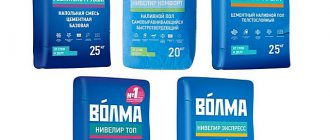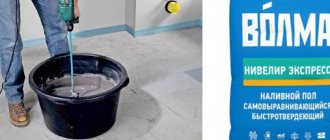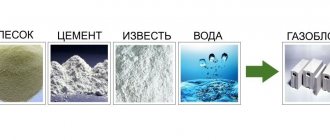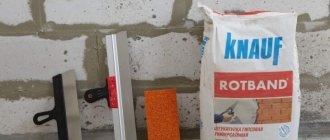Self-leveling floor Level Express from Volma is used for accelerated and high-quality leveling of bases in order to prepare them before finishing and decorative finishing. The scope of application includes internal residential and public buildings, the floor covering placed can be anything from light flooring and linoleum to heavy tiles. Of all the domestic brands, this one is considered the best in terms of cost (prices vary between 250-275 rubles per 20 kg bag), simplicity and speed of work, final quality of leveling; product reviews are mostly positive.
Advantages and disadvantages
Today, the technology, originally developed for the needs of industrial enterprises, is of interest to specialists involved in the construction and repair of office buildings, residential buildings, medical complexes, various institutions... It has confirmed its effectiveness wherever:
- The ability to withstand mechanical loads and the effects of substances of various chemical compositions. It is important for industrial facilities, scientific laboratories and warehouses.
- Resistance to abrasion, mandatory for floor coverings used in high-traffic areas and transport facilities.
- A satisfactory level of fire safety, achieved by complying with the requirements for flammability, combustibility, smoke generation and toxicity of combustion products, which apply to building and finishing materials.
- Hygienic properties. Reviews of the Volma self-leveling floor confirm that ordinary detergents are sufficient to maintain cleanliness in the rooms where such floor coverings are installed.
- Maintainability. Using the same materials and technologies as for pouring floors, it is possible to quickly eliminate even complex damage.
Flaws:
If we add to this durability and affordable cost, it becomes clear why the Volma self-leveling self-leveling floor attracts consumers. For the sake of obvious advantages, users are willing to put up with the existing disadvantages:
- Significant expenditure of effort and money required to prepare the base, laying thermal insulation and sound insulation.
- The high cost of equipment used during the work.
- Specific heat transfer characteristics. No matter how good the Volma self-leveling floor is, comfort in living quarters can only be ensured if heating systems are installed under the floor covering.
- Prices several times higher than the cost of linoleum or laminate floors.
Customers are not even afraid of the complexity of dismantling, the need for which arises for a variety of reasons. The pros outweigh the cons. But there are some nuances.
Working with solution on the surface
Pour the finished mixture first into deeper potholes and cracks with a gradual transition to hills. It is advisable to do all the work by two people. One will prepare the solution, the second will pour it. To level the composition, a needle roller on a telescopic handle and a spatula are usually used. The length of the spikes should not be less than 30 mm.
The solution poured onto the surface is leveled using a spatula so that the resulting strips overlap each other. Upon reaching the edge of a limited area or one of the sides of the room, the composition is passed several times with a needle roller. This is done to eliminate air bubbles from the mixture, forming a flat surface due to the movement of the solution and vibrations.
Before you start pouring the Volma-Nivelir Express solution, you must close the doors, windows and vents so as not to create drafts. If left unaddressed, they can cause surface cracks and reduce the strength of finished floors.
After four hours have passed since the floor was poured, you can move on it; after two days you can begin laying ceramic tiles. Laminate or linoleum is laid only after the surface has completely dried.
Main characteristics of self-leveling floor Volma
Money matters a lot. Even wealthy buyers, looking for an answer to the question of which self-leveling floor is better, pay attention to the cost of materials. Compared to foreign competitors, a Russian enterprise finds itself in an advantageous position, offering its products on favorable terms. But it’s not only the affordable price of Volma self-leveling flooring that attracts consumers. Other characteristics are no less important:
- Mixture consumption. The large amount of ready-made composition required for pouring floors is recognized as a serious drawback. But, in this case, problems, if they exist, are not considered critical. If the contractor has read the instructions and correctly lays the Volma self-leveling floor, the consumption is only slightly higher than when using more expensive materials.
- Drying speed. Some experts who have experience working with products from other companies note that, in their opinion, the Volma Nivelir-Express self-leveling floor hardens too quickly and sometimes does not have time to level. Indeed, the viability of the finished composition does not exceed 40 minutes. However, masters who have mastered the technology object to their colleagues, arguing that it’s all a matter of skills.
Overall, everything looks good. But when assessing the picture as a whole, it should be taken into account that the manufacturer itself positions its products as compositions for leveling floors and preparing the base. The products offered honestly fulfill their purpose. But for normal operation, floor coverings, such as linoleum or laminate, should be laid on the hardened surface, or a protective layer should be applied from materials that are not in the catalog of the Russian enterprise.
Alas, none of the options offered by the company are final. And this, in turn, means that the stories of users about how they successfully use the above-mentioned Volma Level-Express floor or bases made from dry mixtures of other brands produced by the enterprise raise doubts. And no matter how attractive the price may look, if you do not intend to spend money on purchasing and installing additional finishing materials, it is better to give preference to another, albeit not so affordable, option.
Classification methods
Polymer floors are classified according to the following factors:
- degree of fullness;
- type of solvent;
- thickness.
Based on thickness, self-leveling floors are divided into types as follows:
- Thin layer coatings. Their thickness is 0.2-0.6 mm. They don't withstand very heavy loads. Install using a roller or spray.
- Medium thickness. The applied layer can be 0.8-1.5 mm. Such self-leveling coatings can withstand medium loads.
- Highly filled coatings. Their thickness is 2 mm or more. The appearance depends on the characteristics of the filler. Used for decorative and specialized purposes.
Depending on the degree of filling, the material is characterized as follows: the more filler, the rougher the surface.
Popular brands of self-leveling floor Volma
VOLMA-Nivelir Express
"VOLMA - Level Express" is a dry mixture based on a mixed binder, mineral fillers and modifying additives. TU 23.64.10-005-88933857-2020 corresponds to GOST 31358.
For manual or mechanized work on leveling concrete and cement-sand floor subfloors indoors for subsequent decorative coatings (linoleum, laminate, tiles, parquet, etc.) with a thickness of 5 to 100 mm. Recommended for use in residential and public areas with dry and normal humidity levels.
Average price: 228 rub./piece. for 20 kg.
Specifications:
| Recommended layer thickness | 5-100 mm |
| Material consumption for a thickness of 10 mm | 12-14 kg/sq.m |
| Water consumption per 1 kg of dry mixture | 0,29-0,34 |
| per bag 20 kg | 5.8-6.8 l |
| Viability of the solution in the container | 40 minutes |
| Application temperature (air, work surface, materials) | from + 5 to + 30ºС |
| Floor strength | 15 MPa |
| Strength of adhesion to the base | not less than 1.0 MPa |
| Possibility of moving on the floor | in 4-6 hours |
| Possibility to load the floor | in 72 hours |
| Coat with residual moisture | no more than 1% |
VOLMA-Level Comfort
"VOLMA - Level Comfort - a dry mixture based on a mixed binder, mineral fillers and modifying additives. Complies with GOST 31358.
For manual or mechanized work on leveling concrete and cement-sand floor subfloors indoors for any type of finishing coating with a layer thickness from 3 to 100 mm. Recommended for use in residential and public areas with dry and normal humidity levels.
Average price: 228 rub./piece. for 20 kg.
Specifications:
| Application thickness | up to 100 mm |
| Recommended application thickness | 4-100 mm |
| Material consumption for a thickness of 10 mm | 12-14 kg/sq.m |
| Water consumption per 1 kg of dry mixture | 0,29-0,34 |
| per bag 20 kg | 5.8-6.8 l |
| Viability of the solution in the container | 40 minutes |
| Application temperature (air, work surface, materials) | from + 5 to + 30ºС |
| Floor strength | 15 MPa |
| Strength of adhesion to the base | not less than 1.0 MPa |
| Possibility of moving on the floor | in 4-6 hours |
| Possibility to load the floor | in 72 hours |
| Coat with residual moisture | no more than 1% |
Reviews
Boris, Astana: “The material consumption was 1 m2 more than indicated on the packaging. There were also some problems with the amount of water, as they thought. I understand what the consistency should be, I have experience, but what should beginners do who don’t know what is what and sacredly believe what is written on the product.”
Anton, Moscow: “I filled an 18 m2 floor. If you dilute everything strictly according to the instructions, then the mixture turns out thick, and if you pour it alone, then while you take measurements, the previous area will have time to dry out. As a result, it is difficult to make a smooth transition between sections, and it is also difficult to fill a large area at once, which is why the floor turns out to be multi-level. Then I tried mixing 8.5 liters of water per 20 kg of mixture, and then everything went like clockwork. The mixture spread on its own, and everything was smooth, the only thing was that it took a little longer to harden. I drained the excess water into the corridor from the room through a slot in the foam edge, and then covered the entire surface with shavings and sawdust so that the water would be absorbed quickly.”
Useful tips
Before you start pouring, you need to close the doors and windows tightly. This will help prevent the appearance of drafts, which cause cracking of the drying screed. Direct sunlight should also be avoided: their influence negatively affects the quality of the top layer. Relative air humidity should not exceed 75%.
In cases of violation of the pouring technology, excess water getting into the solution or obvious defects of the main surface, the self-leveling floor may crack within a few hours after installation. If the top layer has peeled off or cracked, it is necessary to embroider, remove dust and prime the cracks. Then you need to fill them with the newly prepared Nivelir-Express mixture or repair composition. Subsequently, the repaired surface is reinforced with plaster mesh or fiberglass.
A few simple tips
It is important not to forget that within half an hour after preparing the composition in air, polymerization processes will begin. Therefore, it is advisable to prepare the mixture in portions in order to apply the self-leveling floor before it hardens.
To get the perfect surface quickly and efficiently, it is recommended to work in a team of three people. One will do the pouring, the second will level the already poured solution, and the third will prepare the composition.
Many people think that self-leveling floors are too expensive, but this is not so. When filling according to technology, the consumption of the composition will be minimal. It's better to calculate everything in advance. Unlike other types of coatings, self-leveling floors have a very long service life - it is more than 50 years. This is a significant advantage. You can effectively reduce consumption with the help of an underlying layer, and if the screed is carefully sanded, there are no cracks or cavities in it, then consumption will be completely minimal. No other modern coatings have or will provide the efficiency inherent in self-leveling floors.











